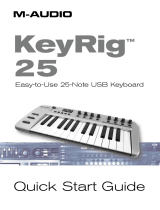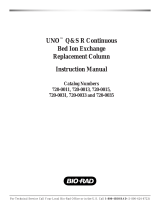Page is loading ...

USB
Uno MIDI Interface Manual
English
Introduction
Thank you for purchasing the Uno. The Uno is a 1x1 MIDI interface for USB-equipped PC and Macintosh
computers and was designed and manufactured by Midiman, a trusted name in MIDI interfaces for over
a decade. Uno’s high speed Universal Serial Bus connection assures reliable and speedy transfer of
MIDI data to and from the computer.
The Uno is self-powered and can be conveniently attached to your computer’s USB port, without the
need for tools or computer disassembly. There’s no need for additional cables—the Uno comes with
integral USB and MIDI cables as part of its sturdy construction.
Follow the installation instructions in this manual and you will be up and running in no time. Expansion
also is easy—for additional MIDI ports, just install more Uno’s!
Features
The Uno USB MIDI Interface has the following features:
• 1-in/1-out MIDI via USB connection (16x16 MIDI channels)
• High-speed connection to PC or Apple computers with USB port
• MIDI input and output indication by LEDs
• Self-powered—requires no external power supply
• Compatible with Mac OS 8.6 and higher (OMS required in OS 8.6 & 9)
• Compatible with Windows 98 and higher—true Plug&Play installation requires no IRQ, I/O
address or DMA channel setup
• Extremely compact size
• 1 Year Warranty

Please thoroughly read the installation instructions before physically installing your Uno. For driver
installation please refer to the section “Software Installation.”
Package Contents
Included in the Uno package are:
• Uno interface
• This manual
• Driver disk for Windows and Macintosh
• Warranty Registration card.
Top View
1. USB Cable & Connector—used to connect the Uno to the host computer’s USB port.
2. USB LED—when pulsing, indicates that the Uno is powered and functioning.
3. MIDI-In and MIDI-Out LEDs—indicate MIDI input or output activity.
4. MIDI-Out cable & connector—sends MIDI signal, from computer, to receiving device.
5. MIDI-In cable & connector—receives MIDI signal from sending device, for output to computer
via USB.

Overview
The Uno provides one MIDI input port and one MIDI output port, with each MIDI port supporting 16 MIDI
channels. MIDI is the acronym for Musical Instrument Digital Interface, and is the protocol used when
MIDI keyboards and devices (devices that record and playback the MIDI information, such as computer
or hardware sequencers) communicate with each other.
On a PC: You must be running Windows 98, or higher, to properly use the Uno. Also, either your
motherboard must support USB. If it does not, you will need to install a PCI-to-USB host adapter to
provide the USB ports. It is possible for a motherboard to support USB and yet not have the physical port
connectors installed. A simple USB back panel extender can be purchased at a computer supply store
and easily installed to provide USB port connectors.
On an Apple Computer: Your computer must support USB and have physical ports present. Standard
iMac’s or G3/G4’s with USB ports are adequate.
IMPORTANT (For Apple users): You MUST use software that supports OMS, and have OMS
properly installed, in order to use the Uno. An OMS MIDI driver is provided for Mac OS 8.6
through 9.x, but is not required for OS X.
Guide To Getting Started
Here is an outline of the steps needed to begin using your Uno on either a Mac or a PC:
1. Attach the Uno to your computer (see "Hardware Installation").
2. Install the Driver (see "Software Installation").
3. Hook your keyboard and sound module to the Uno (see "Setting Up Your
MIDI Studio").
4. Configure the Uno in your application program (see "Using the Uno in your
Application Software").
Hardware Installation
Installing your Uno involves simply attaching it to your USB port using the standard USB cable included
on the Uno. We recommend that you power down (turn off) your computer before connecting the Uno,
during the first installation.
Find a good spot around your computer station to place the Uno. The USB port on your computer is a
small (approx. 1/8" x 3/8") rectangular connector and is often found in a group of two. Take the end of
the USB cable and plug it into the USB port on the back of your computer. Next, power up your computer
and proceed to the next section, "Software Installation."

Software Installation
A software driver is a special, dedicated program that makes a MIDI interface accessible to an
application. On the included driver disk, Midiman supplies the drivers that enable you to use the Uno
with Windows, Mac OS 8.6 through 9.x, or Mac OS X (Opcodes OMS drivers, for Mac users). All Uno
drivers are supplied on the included dual-formatted disk.
On your driver disk there is a "Readme" file that gives step by step instructions on how to install the driver
software. Locate the file entitled "#installMac", for Mac users, or "#install.txt”, for PC users. Double click on
the file name to open it. Carefully follow the instructions given to properly install your driver software.
Setting Up Your MIDI Studio
A typical MIDI system setup would include your Uno, a computer, MIDI sequencing software, a MIDI
controller keyboard and, perhaps, a MIDI compatible sound module. This type of set-up can be
constructed as follows:
1. Connect the Uno, via the USB cable, to the computer’s USB port connector.
2. With a MIDI cable, connect the MIDI Out of a controller keyboard to the MIDI In of the Uno.
3. With a second MIDI cable, connect the MIDI Out of the Uno to the MID I In of a sound module.
(This can also be your MIDI controller keyboard if it has the capability to serve as a sound
module).
In the set-up below, the Uno is being used as a MIDI interface, inputting and outputting MIDI data
between the controller keyboard, the sound module (from which sound will be produced) and the
computer and it’s application software.
Typical Setup

Using the Uno in your Application Software
In order to utilize the Uno, once it’s driver has been installed, you will need to configure your MIDI
application software. The manner in which this is done varies between applications, so it is possible only
to cover basics here.
Generally with both the Mac and PC, most MIDI applications have a MIDI Port configuration or settings
dialog box, titled something like "MIDI Devices" or "MIDI Setup." It is within this dialog box that you will
need toselect or enable your MIDI input and output devices. If the Uno drivers are properly installed, the
port selections in the box should be titled, in the input column, “Uno In-A” (or “Port 1”, on a Mac) and, in
the output column, “Uno Out-A” (“Port 1”, on Mac). “In-A” and “Out-A” (or input and output “Port 1”)
correspond to the physical input and output of your Uno—make sure that youhighlight or check those
items, if they are not already. The output port that you select for a specific MIDI track within your
sequence will output MIDI information to the keyboard or sound module attached to that port.

Contact Information
If you have any questions, comments or suggestions about this product or any M-Audio or Midiman
product, we invite you to contact us directly using the following information:
M-AUDIO U.S.
45 E. Saint Joseph St.
Arcadia, CA 91006-2861
U.S.A.
Sales Information: 626-445-2842
Sales Information (email): [email protected]
Tech Support: 626-445-8495
Tech Support (email): [email protected]
Fax: 626-445-7564
Internet Home Page: http://www.m-audio.com
M-AUDIO U.K.
Unit 5, Saracen Industrial Estate
Mark Rd.
Hemel Hempstead, Herts HP2 7BJ
England
Sales Information: 44 (0) 144 241 6590
Sales Information (email): [email protected]
Technical Support: 44 (0) 871 717 7102
Technical Support (email): [email protected]
Fax: 44 (0) 144 224 6832
Internet Home Page: http://www.maudio.co.uk
M-AUDIO France
Unit 5, Saracen Industrial Estate
Mark Rd.
Hemel Hempstead, Herts HP2 7BJ
England
Sales Information: 0810 001 105
Sales Information (email): [email protected]
Technical Support: 0820 00 731
Technical Support (email): [email protected]
Fax: 44 (0) 144 224 6832
Internet Home Page: http://www.maudio.co.uk
M-AUDIO Deutschland (Germany)
Kuhallmand 34

D-74613 Ohringen
Germany
Sales Information: 49 7941 98 7000
Sales Information (email): [email protected]
Technical Support: 49 7941 98 70030
Technical Support (email): [email protected]
Fax: 07941 98 70070
Internet Home Page: http://www.m-audio.de
M-AUDIO Canada
1400 St-Jean Baptiste Ave., #150
Quebec City, QC G2E 5B7
Canada
Tel: 418-872-0444
Fax: 418-872-0034
Email: [email protected]
Internet Home Page: http://www.m-audio.ca
/


